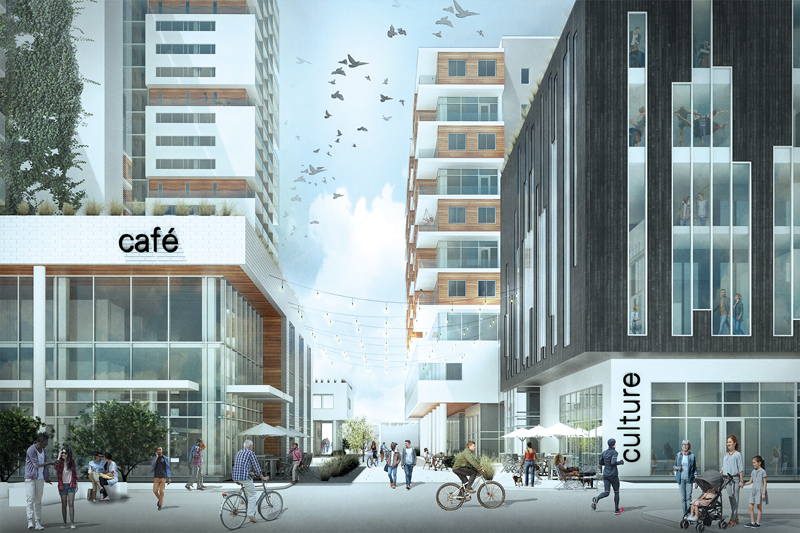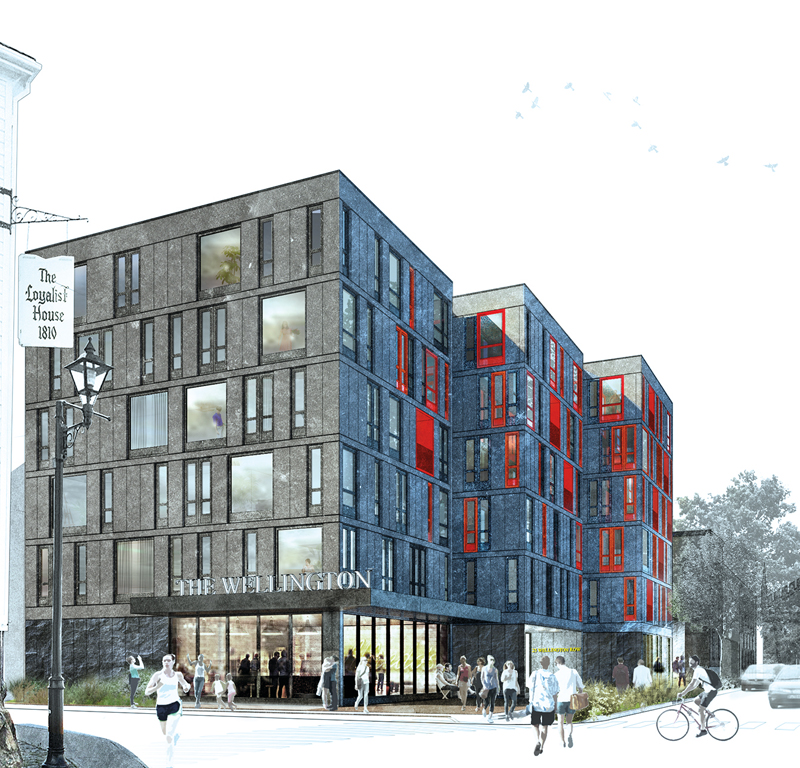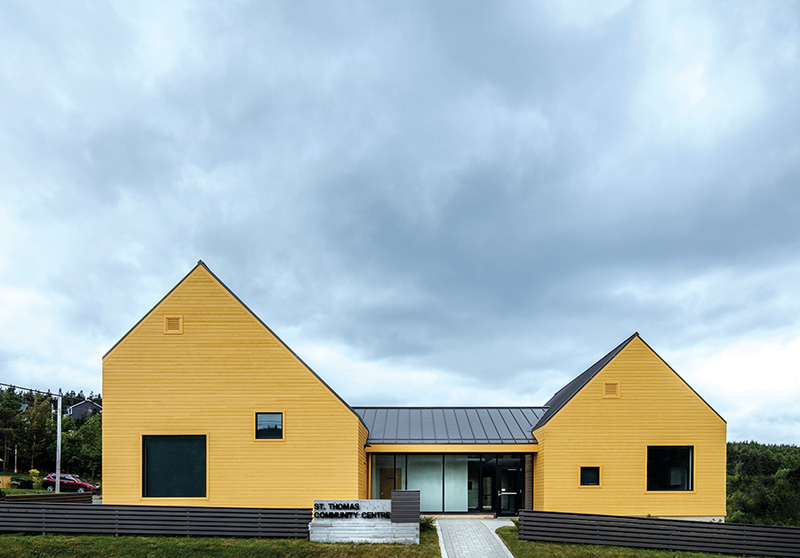State of the Nation: Atlantic
The postcard view of Canada’s Atlantic coast is dotted with small, colourful clapboard houses sitting by the ocean. But in some parts of the Atlantic, that’s starting to change, with a growing appetite for contemporary design, and a contingent of architects ready to deliver it.
“When the Halifax Central Library opened, it changed many people’s perceptions about what a modern building could bring to the city,” says Rayleen Hill, of RHAD Architects. The opening of the library in 2014 coincided with a real estate boom in the city: construction has been on the rise, with a record number of housing starts in 2018.
There’s a sense of economic optimism that’s unusual for the fiscally conservative city. It’s anchored, perhaps, in the thriving Irving shipyard, which secured a $25-billion package for building federal combat vessels in 2011, and earlier this year was part of a team selected to design and construct another $60 billion of military ships.
“When I first arrived in Halifax 25 years ago, there were massive parking lots in the city,” recalls Susan Fitzgerald, of FBM Architecture & Interior Design. “Now, new communities are being created on those sites.”

One of the most visible development projects is Queen’s Marque, a set of residential midrises on the downtown waterfront by MacKay-Lyons Sweetapple and FBM that includes public areas. There’s also anticipation building around the municipality’s plan to replace the Cogswell Interchange—a concrete snarl that caps the north end of downtown—with a pedestrian-oriented district centred on parks, plazas and a transit hub.
Affordability is increasingly an issue, and developers are responding in projects such as Midtown North, which includes a significant component of below-market-value rentals. The five-acre parcel, designed by FBM, weaves together a mix of building types and scales, and includes a plaza for weekend markets. RHAD is designing a 30-unit affordable housing project in Bridgewater, a community just outside the city that recently won a $5-million pot in the federal Smart Cities Challenge. Bridgewater’s proposal intends to lift residents out of energy poverty, including through providing better housing that reduces energy expenses.
The Nova Scotia coast is also upgrading its tourism infrastructure, in both public venues and private enterprises. Among the rising stars are the globally acclaimed Cabot Links and Cabot Cliffs golf courses, which have transformed the landscape and economy of a former mining community. FBM has contributed handsome structures to each.
A side-effect of tourism is an uptick in residential projects. “We’ve seen a lot of clients from overseas or out west who have become enamoured with the Nova Scotian landscape and have purchased waterfront properties around the province,” says Rayleen Hill. “Some lived or went to university here, others have vacationed here, and now want to build a summer home where they can eventually retire.”

by RHAD Architects to reference the typology of local barns. Photo by Doublespace
In neighbouring New Brunswick, there is a similar boom in the vacation home market—even though the provincial government is in a non-building phase of austerity. “We recently did an audit of our commissions, and found 85 percent of our clients are from out-of-province,” says Stephen Kopp of Saint John-based Acre Architects, a draw that he attributes in part to the attractiveness of the Bay of Fundy coastline. Kopp also notes that there has been a drift of people from the suburbs back into the city core. In line with the trend, one of their current projects is a six-storey, Passive House-standard multi-unit residential build. “This will be a big statement locally to show how high sustainability standards and high design ambitions can work together,” he says.

Throughout the Atlantic coast, climate change has been palpable: there’s been major flooding in New Brunswick, Arctic sea ice blowing down the coast of Newfoundland, and invasive species like European Green Crab coming up regularly in fishing nets. Perhaps as a result, private house clients, universities and specific municipalities seem interested in building with sustainability in mind. But government policy and regulations have to catch up.
The potential exists for the buildings sector to make a significant impact: the relatively moderate climate of Newfoundland, for instance, means that geothermal fields are remarkably effective. “You can run almost 100 percent of a building’s heating and cooling on geothermal,” says Jeremy Bryant of St. John’s-based Lat49, who notes a short payback time of five to six years.
Of the Atlantic provinces, Newfoundland’s economy is struggling the most, as it continues to recover from the fallout of the oil and gas price crash several years ago. The capital-poor provincial government has relied on P3s as a way to finance major projects, including the $120-million Corner Brook hospital, a mental health facility in St. John’s, and a number of long-term care facilities.
“We’ve done several long-term care homes in the past, but now, we don’t even get looked at unless we’re linked to an outside firm,” says Richard Symonds of Lat49, who is concerned that the province lacks understanding of the full implications of using this type of procurement. With only 35 local members across Newfoundland and Labrador, notes Symonds, the architecture community has little influence with government officials. The situation may be somewhat different in the Maritime provinces. Says Susan Fitzgerald of Halifax-based FBM, “I actually see a growing desire to work with local firms with their deep local knowledge—especially as Atlantic architects receive more press and win national and international accolades.”
Still, Newfoundland and Labrador’s architects do what they can, particularly in advocating for architecture. The developments at Fogo Island continue to have a positive impact for design culture, with the international draw of the Fogo Island Inn bringing attention to the transformative potential of architecture. With the help of Canada Council grants, the Newfoundland and Labrador Association of Architects runs an annual architecture week and hosts lectures throughout the year.

As in Saskatchewan, there’s the sense that a local design school would be of help in bolstering the status of architecture in the province—perhaps an outpost of Dalhousie University’s School of Architecture. Architect Chris Woodford, of Newfoundland-based Woodford Sheppard, says that design throughout the Atlantic would also be well-served by closer links between the architects in its different provinces. “It’s cheaper for me to fly to London, England, than to St. John, New Brunswick,” he says. “There’s good design happening in various pockets in the region, but it’s difficult for me to even see architectural work designed by my peers in other Atlantic provinces. It’s also difficult to collaborate and to work in different cities, because of the physical obstacles of getting around.”
Regional connections may be strengthened by the advent of Building Equality in Architecture Atlantic (BEAA), an offshoot of Toronto-based organization BEAT, which supports diversity in the profession. With the launch of a PEI chapter in June, BEAA now has a presence in each of the Atlantic provinces. This fall, they’re planning a regional retreat in New Brunswick, and hoping to make it an annual event.
“Despite our small number of registered architects in Atlantic Canada—and with even fewer women architects—there is a palpable feeling of growth and progress with the launch of BEAA,” says Monica Adair of Acre Architects, who spearheaded the initiative. “A shared dedication to the larger mission of helping shape our profession to be more diverse is resulting in a more connected ecosystem. This is vital especially for the smaller provinces, where the architect is not always top of mind, and where we must together address our value in society.” It may be just the kind of energy that’s needed to build a stronger culture of architecture within the region.
This article is part of our State of the Nation series covering Canadian architecture region by region.
